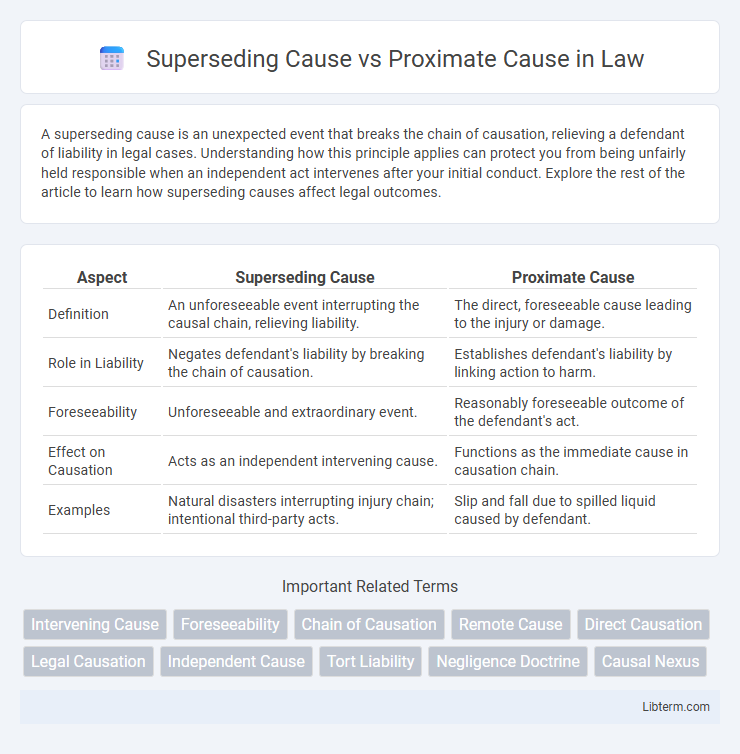A superseding cause is an unexpected event that breaks the chain of causation, relieving a defendant of liability in legal cases. Understanding how this principle applies can protect you from being unfairly held responsible when an independent act intervenes after your initial conduct. Explore the rest of the article to learn how superseding causes affect legal outcomes.
Table of Comparison
| Aspect | Superseding Cause | Proximate Cause |
|---|---|---|
| Definition | An unforeseeable event interrupting the causal chain, relieving liability. | The direct, foreseeable cause leading to the injury or damage. |
| Role in Liability | Negates defendant's liability by breaking the chain of causation. | Establishes defendant's liability by linking action to harm. |
| Foreseeability | Unforeseeable and extraordinary event. | Reasonably foreseeable outcome of the defendant's act. |
| Effect on Causation | Acts as an independent intervening cause. | Functions as the immediate cause in causation chain. |
| Examples | Natural disasters interrupting injury chain; intentional third-party acts. | Slip and fall due to spilled liquid caused by defendant. |
Introduction to Causation in Law
Superseding cause and proximate cause are critical concepts in the legal framework of causation, determining liability in tort law. Proximate cause refers to an event closely enough related to an injury, establishing direct legal responsibility, while superseding cause is an unforeseeable, intervening act that breaks the chain of causation, relieving the original defendant of liability. Understanding how courts distinguish these causes aids in analyzing duty, breach, and foreseeability within negligence claims.
Defining Proximate Cause
Proximate cause refers to a primary event that leads directly to an injury, establishing a clear causal link necessary for legal liability. It focuses on whether the harm was a foreseeable result of the defendant's actions, limiting liability to consequences closely connected to the conduct. In contrast, superseding cause is an intervening event that breaks the chain of causation, absolving the original actor from responsibility for subsequent harm.
Understanding Superseding Cause
Superseding cause refers to an unforeseeable event that interrupts the chain of causation, relieving the original defendant of liability for the plaintiff's harm. It occurs after the defendant's negligent act and is significant enough to be considered the primary cause of the injury, overshadowing the initial wrongdoing. Recognizing superseding cause is crucial in tort law to determine whether the original defendant's actions remain legally responsible for the damage incurred.
Key Differences: Proximate vs Superseding Cause
Proximate cause refers to the primary cause that directly results in an injury or damage, establishing a clear link between the act and the harm. Superseding cause interrupts the chain of causation by introducing an unforeseeable, independent event that relieves the original actor of liability. Key differences highlight that proximate cause predicts liability based on foreseeability, while superseding cause absolves liability by breaking direct causation with unexpected external factors.
Legal Standards for Determining Causation
Legal standards for determining causation distinguish superseding cause as an unforeseeable intervening act that breaks the chain of liability, whereas proximate cause focuses on foreseeability and directness in linking the defendant's conduct to the plaintiff's injury. Courts apply the foreseeability test to proximate cause, assessing whether the harm was a natural and probable consequence of the defendant's actions. Superseding causes relieve the original wrongdoer from liability when extraordinary or unforeseeable events intervene and produce the harm instead.
Common Examples of Proximate and Superseding Causes
Common examples of proximate causes include car accidents caused by reckless driving and workplace injuries resulting from unsafe equipment. Superseding causes often involve unforeseeable events such as natural disasters or intentional criminal acts that break the chain of causation. Understanding these distinctions is crucial in legal contexts to determine liability and foreseeability of harm.
Role of Foreseeability in Causation
Superseding cause interrupts the chain of causation by introducing an unforeseeable event that relieves the original actor from liability, whereas proximate cause limits liability to consequences reasonably foreseeable at the time of the negligent act. Foreseeability plays a critical role in establishing proximate cause, as courts determine whether the harmful result was a natural and probable consequence of the defendant's conduct. When an intervening act is deemed unforeseeable, it is classified as a superseding cause, thereby breaking the causal link between the defendant's initial negligence and the ultimate harm.
Impact on Liability and Legal Outcomes
Superseding cause can relieve a defendant from liability by interrupting the chain of causation, whereas proximate cause establishes a direct link between the defendant's actions and the harm. Courts analyze superseding causes to determine if an unforeseeable event was the actual cause of injury, often reducing or eliminating defendant liability. Proximate cause ensures legal responsibility if the harm was a foreseeable result of the defendant's conduct, significantly influencing the outcome of negligence claims.
Landmark Cases Illustrating Both Causes
The landmark case of Palsgraf v. Long Island Railroad (1928) exemplifies proximate cause by establishing the foreseeability of harm as a key factor in liability determination. In contrast, the case of Derdiarian v. Felix Contracting Corp. (1980) illustrates a superseding cause, where an unforeseeable intervening event breaks the chain of causation, relieving the initial defendant of liability. These cases collectively highlight the legal distinction between proximate cause, which maintains liability within reasonable predictability, and superseding cause, which introduces an independent, unforeseeable event absolving prior actors.
Conclusion: Why the Distinction Matters in Legal Analysis
The distinction between superseding cause and proximate cause is crucial in legal analysis because it determines liability and the extent of damages awarded. Proximate cause links an act directly to harm, while a superseding cause breaks the chain of causation, potentially relieving a defendant of responsibility. Understanding this difference ensures accurate application of tort law principles and fair outcomes in personal injury and negligence cases.
Superseding Cause Infographic

 libterm.com
libterm.com